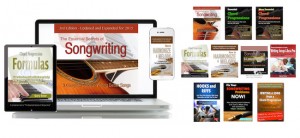One way to work out song melodies is to identify the basic range as a starting point.
 “The Essential Secrets of Songwriting” 10-eBook Bundle is written by Gary Ewer, designed to straighten out your technique and get you writing better songs.
“The Essential Secrets of Songwriting” 10-eBook Bundle is written by Gary Ewer, designed to straighten out your technique and get you writing better songs.
 In the previous post, we looked at the value of working backwards in songwriting, starting with lyrics, and then moving on to chords. Now let’s take a look at song melodies and see if working backwards can help us there.
In the previous post, we looked at the value of working backwards in songwriting, starting with lyrics, and then moving on to chords. Now let’s take a look at song melodies and see if working backwards can help us there.
It doesn’t work as well to literally work backwards when writing melodies, but there is one important thing you can do: work out a melodic range first for your bridge (which will often contain your highest notes), then work out a range for your chorus, and then finally for your verse. Here’s how that works:
- Work out the chord progressions for your song, one for the verse, one for the chorus and one for the bridge.
- Improvise melodies as you play through the progressions. Don’t worry if you don’t come up with anything earth-shattering at this point. It’s most important just to get the sense of a song, a mood, and a feel.
- On a piece of paper, write down your highest note, then find the note that’s four notes lower, and write it down in front of that note. So if G is your highest note, you’ll have written D-G. That’s the note range you’re going to aim for in your bridge.
- Now write down the note that’s a major second lower than your highest bridge note, and then precede it with a note four notes lower. In our example, you’ll have just written: C-F.
- Now write down the note that’s a 4th lower than your lowest chorus note, and precede it with a note four notes lower. That gives you: D-G.
So here’s what you’ve got:
- Verse Range: Low D to G.
- Chorus Range: High C to F.
- Bridge Range: High D to G.
Now, that in no way means that you can’t stray out of those ranges, and in fact, you’ll probably want to. But it helps as a reminder that most of your notes of your verse should stay lower, in the D to G range, with some possibly moving lower and/or higher, particularly as it moves from verse to chorus.
By working out the ranges this way, backwards from the bridge, you’ve got a great way to keep control of vocal energy, and that translates to solid melodic direction.
______________
Written by Gary Ewer. Follow on Twitter. “The Essential Secrets of Songwriting” eBook Bundle looks at songwriting from every angle, and has been used by thousands of songwriters. How to use chords, write melodies, and craft winning lyrics.










